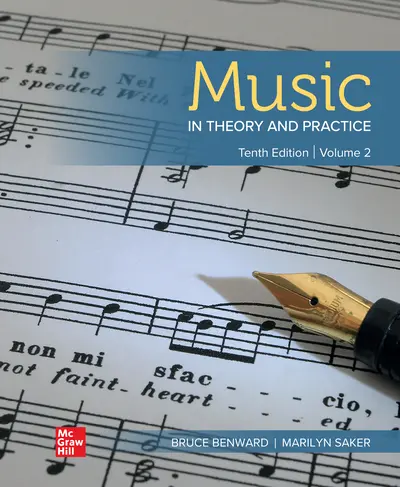My Account Details

ISBN10: 1260493466 | ISBN13: 9781260493467

* The estimated amount of time this product will be on the market is based on a number of factors, including faculty input to instructional design and the prior revision cycle and updates to academic research-which typically results in a revision cycle ranging from every two to four years for this product. Pricing subject to change at any time.
Instructor Information
Quick Actions (Only for Validated Instructor Accounts):
This best-selling program gives music majors and minors a solid foundation in the theory of music. Music in Theory and Practice 10e strengthens musical intuition, builds technical skills, and helps gain interpretive insights. The goal of the content is to instruct readers on the practical application of knowledge. The analytical techniques presented are carefully designed to be clear, uncomplicated, and readily applicable to any repertoire.
The two-volume format ensures exhaustive coverage and maximum support for students and faculty alike. Volume I serves as a general introduction to music theory while Volume II offers a survey of the theoretical underpinnings of musical styles and forms from Gregorian Chant through the present day. The supplemental instructor's materials provide clear-cut solutions to assignment materials. Music in Theory and Practice is a well-rounded program that integrates the various components of musical structure and makes them accessible to students at the undergraduate level.
Resources available from the Connect Online Learning Center include printable versions of the Instructor’s Manuals and Workbook Solutions Manuals, audio files, assignment templates compatible with Finale® Music Notation software, supplementary drill assignments, testing materials, and recordings. Audio files available for this edition of Music in Theory and Practice are identified throughout the texts and workbooks with the ♫ graphic.
Part C: The Renaissance And Baroque Periods
Chp. 18: Late Renaissance Polyphony
Chp. 19: Two-Voice Eighteenth Century Counterpoint
Chp. 20: The Fugue
Part D: Chromatic Harmony
Chp. 21: Borrowed Chords
Chp. 22: Neapolitan 6th Chords
Chp. 23: Augmented 6th Chords
Part E: The Classical Period
Chp. 24: Variation Technique
Chp. 25: Sonata Form
Chp. 26: Rondo Forms
Part F: Extended And Chromatic Harmony
Chp. 27: 9th,11th, and 13th Chords
Chp. 28: Altered Dominants
Chp. 29: Chromatic Mediants
Part G: The Nineteenth And Twentieth Centuries
Chp. 30: The Romantic Period
Chp. 31: The Post-Romantic Style
Chp. 32: Impressionism and Related Styles
Chp. 33: The Early Twentieth Century
Chp. 34: Pitch-Class Set Theory
Chp. 35: Twelve-Tone Technique
Postlude: Music Since 1945
Appendix G Summary of Part-Writing Practices
Appendix H Macro Analysis Symbols
Appendix I Popular Music Chord Symbols
Glossary
Credits
Index
Need support? We're here to help - Get real-world support and resources every step of the way.
